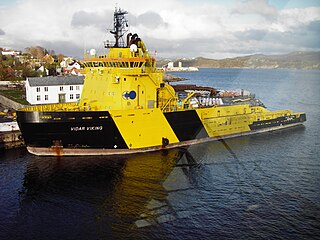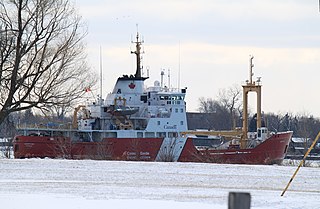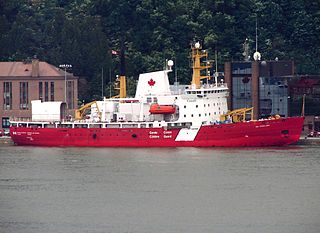 W
WThe Martha L. Black-class icebreakers are a class of six light icebreaker and buoy tenders constructed for and operated by the Canadian Coast Guard. Built in the 1980s, the class operates on both coasts of Canada and have been used for operations in the Arctic region, including the search for the ships of Franklin's lost expedition. They are rated as "high endurance multi-tasked vessels" under Canadian Coast Guard naming rules.
 W
WThe Samuel Risley-class icebreakers are a class of two icebreakers and buoy tenders constructed for and operated by the Canadian Coast Guard. The two ships are based on offshore supply tugboat design and entered service in the 1980s. Samuel Risley is deployed to the Central Region, operating mainly on the Great Lakes of North America while Earl Grey is posted to Atlantic Canada, working off the east coast of Canada.
 W
WCCGS Alexander Henry is a former Canadian Coast Guard light icebreaker and buoy tender that served on the Great Lakes from 1959 to 1984. In 1986, the vessel was handed over to the Marine Museum of the Great Lakes in Kingston, Ontario for preservation as a museum ship. Previously, during the summer months the vessel was also operated as a bed and breakfast. In 2017, the ship was sold to The Lakehead Transportation Museum Society in Thunder Bay, Ontario and in June, was relocated to the Pool 6 site on the town's harbour front, where Alexander Henry continues as a museum ship.
 W
WCGS Bradbury is a retired fisheries patrol vessel for the federal Department of Transport's Marine Services, constructed in 1915. The vessel was sold to commercial interests in 1935. The ship was removed from service in 1973 and became a museum ship on static display at the Marine Museum of Manitoba.
 W
WCCGS Captain Molly Kool is a Canadian Coast Guard converted medium class icebreaker. She was originally built as an icebreaking anchor handling tug Vidar Viking for Trans Viking Icebreaking & Offshore in 2001. The vessel was acquired by the Canadian Coast Guard in August 2018 and was commissioned in May of the next year after refit.
 W
WThe icebreaker Fyodor Litke was active in the Soviet era in the Arctic, until the late 1950s. It was built in 1909 in England for the Saint Lawrence River service and initially named CGC Earl Grey after Albert Grey, Governor General of Canada. After four years in Canada it was sold to the Russian government and eventually renamed Fyodor Litke in honour of the Arctic explorer Fyodor Petrovich Litke.
 W
WCanadian Coast Guard Ship Griffon is a Canadian Coast Guard (CCG) high endurance multi-tasked vessel and light icebreaker stationed in Prescott, Ontario, Canada. Completed in 1970, Griffon provides icebreaking services along eastern Lake Ontario and upriver along the Saint Lawrence River to Montreal.
 W
WCCGS Jean Goodwill is an icebreaking anchor handling tug supply vessel (AHTS) being converted to a medium class icebreaker for the Canadian Coast Guard. She was originally built as Balder Viking for Trans Viking Icebreaking & Offshore AS in 2000. The vessel was acquired by the Canadian Coast Guard in 2018 and was initially expected to enter service in late 2019. However, due to delays the conversion of the vessel is now expected to be completed in late 2020.
 W
WCCGS John A. Macdonald was a Canadian Coast Guard heavy icebreaker. She was named after The Right Honourable, Sir John Alexander Macdonald, the first Prime Minister of Canada. The ship was commissioned into the Canadian Department of Transport's Marine Service in 1960 using the prefix "Canadian Government Ship" (CGS). The vessel was transferred in 1962 into the newly created Canadian Coast Guard (CCG) and served with distinction until being decommissioned in 1991, and replaced by the then-chartered CCGS Terry Fox.
 W
WCCGS John G. Diefenbaker is the name for a Canadian Coast Guard icebreaker that had been expected to join the fleet in 2021–2022 but now is significantly delayed. The ship had initially expected to be in service by 2017. Her namesake, John G. Diefenbaker, was Canada's 13th prime minister. It was Diefenbaker's government that founded the Canadian Coast Guard in 1962.
 W
WCCGS Louis S. St-Laurent is a Canadian Coast Guard Heavy Arctic Icebreaker. Louis S. St-Laurent's home port is St. John's, Newfoundland and Labrador and is stationed there with other vessels of the coast guard.
 W
WAlmirante Óscar Viel is an icebreaker in service with the Chilean Navy since 1995. Originally in service with the Canadian Coast Guard as CCGS Norman McLeod Rogers, it was named for former Canadian Member of Parliament and cabinet minister Norman McLeod Rogers (1894–1940). It is currently named for Counter Admiral Oscar Viel Toro (1837–1892), who was the commander of the Chilean naval forces from 1881–1883 and 1891.
 W
WThe Pierre Radisson-class icebreakers, also known as R-class icebreakers, are a class of four icebreakers constructed for and operated by the Canadian Coast Guard. The Canadian Coast Guard designates the four ships in the class as medium icebreakers. Built in two phases, the first three ships, Pierre Radisson, Franklin and Des Groseilliers, were built to a common design. The fourth, Henry Larsen was built to a modified design and is considered a subclass, the Improved R-class icebreaker. Franklin was later renamed Sir John Franklin before undergoing a re-design for use primarily as an Arctic research vessel. Upon the vessel's return to service, the ship was once again renamed Amundsen. All the vessels are named for people who sailed through Canada's northern waters. The class operates in the Arctic Ocean in the summer, patrolling, icebreaking and research missions.
 W
WThe Polar 8 Project was a Canadian shipbuilding project intended to provide the Canadian Coast Guard with a large icebreaker capable of operating year-round in the Northwest Passage. The project was developed as a means to assert Canada's sovereignty in the Arctic Ocean. It commenced in 1985 but was cancelled in 1990 while still in the final design stage. It was Canada's direct response to the unauthorized transit through the Northwest Passage in summer 1985 by USCGC Polar Sea, a United States Coast Guard icebreaker. Polar 8 refers the capability of the ship in ice of that thickness in feet, in this case 8 feet (2.4 m). Initiated in 1985, the vessel was never constructed and the project was cancelled in 1988.
 W
WCCGS Sir Humphrey Gilbert was a Canadian Coast Guard light icebreaker and buoy tender and now a privately owned Arctic icebreaker Polar Prince. The ship entered service with the Department of Transport Marine Service in 1959 and transferred to the newly created Canadian Coast Guard in 1962, active until 1986. The icebreaker was sold to private interests in Newfoundland and the ship sat idle after 2001 until resold in 2009 to GTX Technology Canada Limited and renamed Polar Prince. Rebuilt, the icebreaker is now plying the waters of the Arctic Ocean. In 2017, the vessel was temporarily rechristened Canada C3 and used for a high-profile voyage around Canada's three maritime coasts as part of the nation's 150th anniversary.
 W
WCCGS Sir Wilfred Grenfell is a Canadian Coast Guard vessel based in Victoria, British Columbia. Designated an Offshore Ice Strengthened Multi Patrol Vessel, the former offshore supply vessel is named after the medical missionary in Labrador, Sir Wilfred Grenfell. Constructed in 1984–1985, Sir Wilfred Grenfell was purchased by the Canadian Government and converted for Coast Guard service. In 1994, she played an important role in the Turbot War in the Atlantic Ocean.
 W
WCCGS Terry Fox is a Canadian Coast Guard heavy icebreaker. She was originally built by Burrard-Yarrows Corporation in Canada in 1983 as part of an Arctic drilling system developed by BeauDril, the drilling subsidiary of Gulf Canada Resources. After the offshore oil exploration in the Beaufort Sea ended in the early 1990s, she was first leased and then sold to the Canadian Coast Guard.
 W
WCCGS Tracy was a Marine service vessel and navigational aid tender operated by the Canadian Coast Guard. Designed for service on the Great Lakes and the Saint Lawrence River, the ship joined the fleet in 1968 and was stationed at Canadian Coast Guard Base at Sorel, Quebec and serviced the Quebec Region. The vessel was taken out of service in 2013 and was sold in 2017 to private interests.
 W
WCCGS Vincent Massey is an icebreaking anchor handling tug supply vessel (AHTS) being converted to a medium class icebreaker for the Canadian Coast Guard. She was originally built as Tor Viking for Trans Viking Icebreaking & Offshore AS in 2000 and has also traded under the name Tor Viking II. The vessel was acquired by the Canadian Coast Guard in 2018 and was initially expected to enter service in summer 2020. However, the conversion work has been delayed and the delivery date is not known as of July 2020.